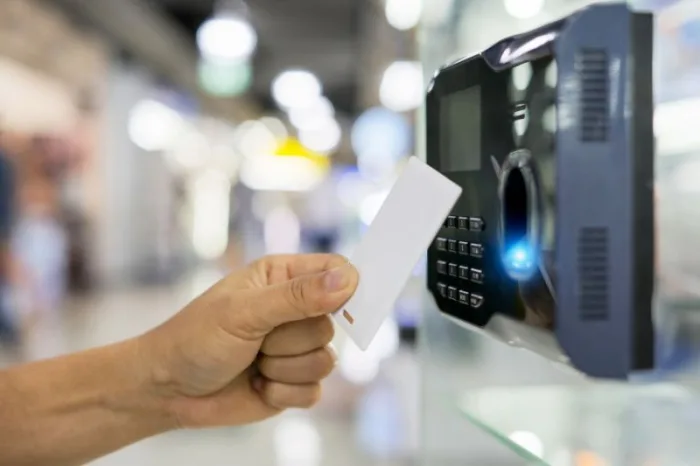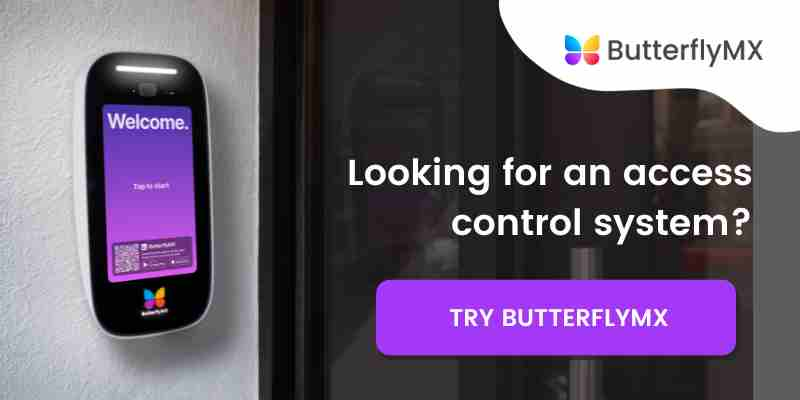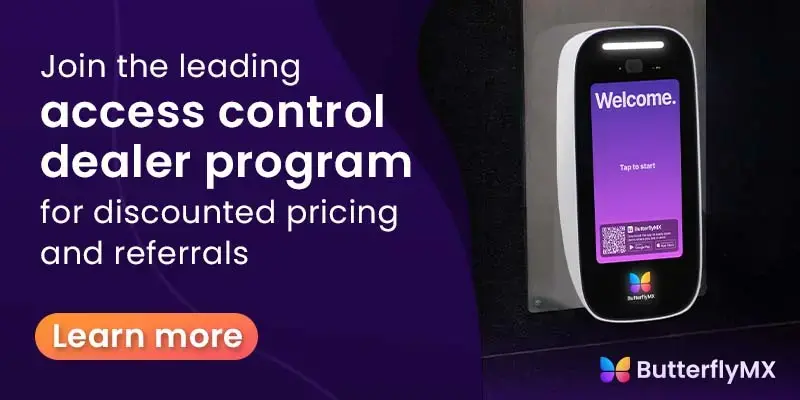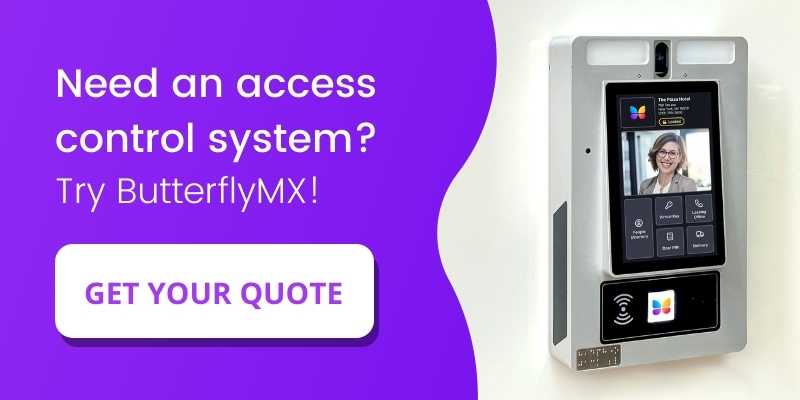Key takeaways
- The best proximity card readers are the ButterflyMX mullion readers.
- Proximity card readers are contactless devices that read a card’s data to grant or deny access to a user.
- Proximity cards are part of an access control system that also includes a proximity card reader and an access controller.
- Before purchasing a proximity card reader, consider the cost, size, installation, and software.
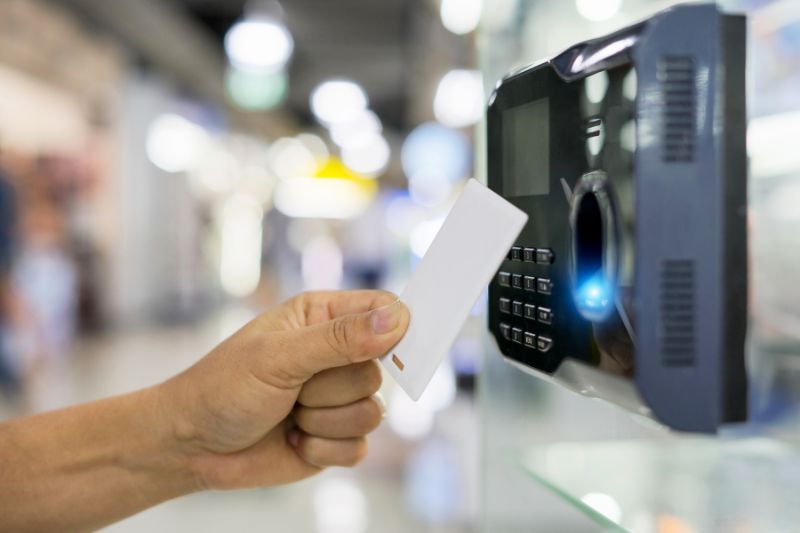
Managing access to certain areas of a property can be difficult, especially with traditional keys. Fortunately, modern technologies like proximity card readers make access control easier and more convenient. Access control card readers are a popular access solution for many types of properties.
This guide will cover what proximity card readers are and how they work. Then, you’ll also learn what you should consider before making a purchase and discover five of the most common card reader systems. Finally, you’ll learn which proximity card reader is best for your property.
This post covers:
- 5 best proximity card systems
- What are proximity card readers?
- How do proximity card readers work?
- Pros and cons of proximity cards
- Considerations for buying a proximity card reader
5 best proximity card systems
With numerous proximity ID card systems on the market, it can be hard to narrow down the best. So, we’ve compiled a list of four of the most common systems to help you choose.
Five common proximity card readers:
- ButterflyMX mullion reader
- HID proximity card reader
- AWID card reader
- Indala card reader
- Paxton card reader
1. ButterflyMX mullion reader
The best proximity card reader is ButterflyMX’s mullion reader.
This is because the ButterflyMX mullion reader is a proximity card reader that connects to the larger ButterflyMX access control ecosystem. By keeping the information in one database, access control is made seamless. So, residents and guests alike experience easier property-wide access. What’s more, if a tenant loses or forgets their credential, the mullion reader can unlock doors with the ButterflyMX mobile app with swipe-to-open!
Pros:
- Accepts multiple forms of credentials, including key cards and fobs, Bluetooth, and the ButterflyMX mobile app.
- Capable of withstanding 95% humidity and temperatures ranging from -40 to 140° Fahrenheit.
- Built with tamper-resistant technology.
- Authorization is signaled by beeping and lighting.
- Additionally connects to other ButterflyMX access control products for a seamless property access solution.
- Manage users remotely using the ButterflyMX OS.
Cons:
- ButterflyMX is specially designed for multifamily buildings, commercial properties, industrial facilities, student housing, salon suites, and more. However, it isn’t ideal for single-family homes.
2. HID proximity card reader
The HID wireless card reader is a flexible option that effortlessly integrates with physical access control solutions.
Pros:
- HID proximity card reader app grants users the ability to open doors with their smartphones.
- 24” read range for convenient access.
- Compatible with smart cards, fobs, and tags.
Cons:
- May be susceptible to technical difficulties in the event of a power outage.
3. AWID card reader
AWID, Applied Wireless IDentifications Group, Inc., is one of the leaders in RFID technologies.
Pros:
- The company focuses its attention on RFID modules, tags, and readers.
- Readers are affordable and start at $82.
- Readers are available in different colors and finishes.
Cons:
- Uses low-frequency technology. So, their readers have a short range and may be slower than some high-frequency readers.
4. Indala card reader
Indala’s line of HID proximity cards uses RFID to provide wireless identification and authorization.
Pros:
- Like a key fob, the Indala proximity badge allows tenants to open doors without looking for keys or going through a security check.
- Choose between mid- and long-range frequency readers.
- Can be installed both indoors and outdoors.
Cons:
- Each programmed card costs $6.20, and a minimum purchase of 100 units is required.
5. Paxton card reader
Paxton creates security solutions for buildings in the education, retail, healthcare, commercial, and leisure industries.
Pros:
- Their proximity readers can read both token credentials and cards.
- Readers are preactivated out of the box.
- Further, is simple to install.
Cons:
- Unfortunately, Paxton card readers are limited to commercial spaces, rather than residential ones.
What are proximity card readers?
Proximity card readers are touchless devices that read the credentials of a key card when it enters a detection radius.
So, the reader doesn’t require users to swipe or tap their card. Instead, it scans the card’s stored data within a certain range. Then, if it reads an authorized credential, it will unlock the door or gate to allow entry.
Learn more about access control:
What is a proxy card used for?
Proxy cards, short for proximity cards, are used to gain entry to an area using proximity card readers. So, the PVC key card stores a small amount of data on a tag that readers pick up from a certain distance.
Depending on certain factors, proxy cards may not require you to pull them out of your pocket or bag. Of course, the reader detection radius varies from system to system, but proxy cards only need to get within a couple of feet from the reader for access to be granted.
What is the difference between a smart card reader and a proximity reader?
The difference between smart card readers and proximity readers is their capabilities.
Proximity access cards are strictly limited to access control because of the small amount of data they can store.
Conversely, smart cards can store more data, giving them greater capabilities than proxy cards. Aside from access control, smart cards are used for secure printing, digital payments, network security, and more.
What is the difference between RFID and proximity cards?
The difference between RFID (radio frequency identification) and proximity cards is that RFID is a type of data transmission technology, while a prox card is the actual credential used to store data. However, most proximity badge readers operate with RFID technology.
RFID encodes data from a tag and transfers it to a reader via radio waves. So, some RFID cards require contact with a reader, while others have a strong enough signal for contactless entry, hence proximity cards.
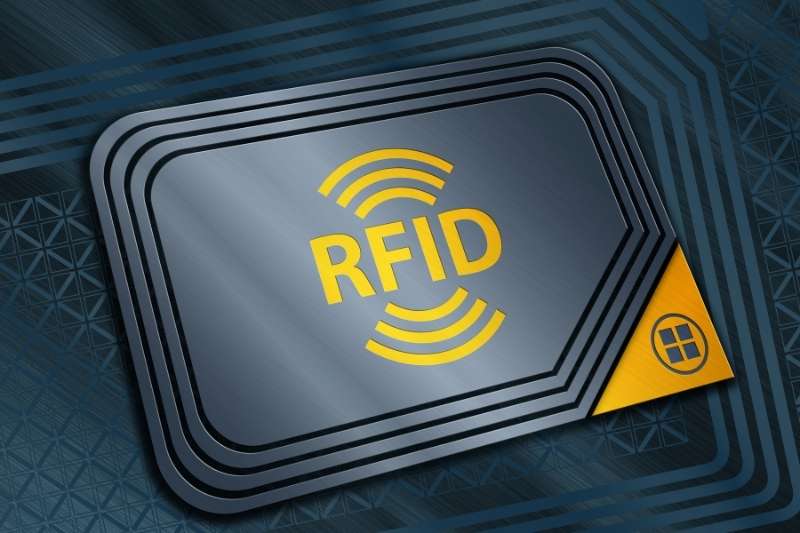
How do proximity card readers work?
Proximity cards work with three components:
- Proxy card: The card contains an antenna and RFID or NFC (near-field communication) tag with stored data detailing the individual’s credentials.
- Proximity reader: The reader is installed near an entryway. From there, the reader emits an electromagnetic field to create a radius. Once the card enters that field, it absorbs some of the energy to convert it into electricity. Then, it has enough power to transfer the data stored on the tag.
- Access controller: Finally, the reader sends the data to the access controller, which determines if access should be granted. If the credentials are accepted, the access controller will release the door lock for entry.
Can proximity cards be demagnetized?
Yes, proximity cards can be demagnetized when closely exposed to a strong magnet.
This is a common problem for those who store their proxy cards in a bag or pocket where magnets may be present. To avoid this issue, consider using smart RFID cards because they’re not as easily influenced by their environment and store more data.
How long do proximity cards last?
The typical lifespan of a proximity card is 2-5 years.
However, there are several factors that can lead to proxy cards failing prematurely:
- Exposing the card to strong magnetic fields
- Damage to the antenna, or the bond between the antenna and the card’s chip
- Exposing the card to electrostatic discharge
- Exposing the card to extreme heat
- Bending or crimping the card
- Accidentally machine washing the card
Pros and cons of proximity cards
Proximity card readers for doors offer a convenient and efficient means of granting access.
However, they come with their own set of advantages and disadvantages.
What are the advantages of a proximity card?
- Enhanced security. Only individuals with authorized access cards can access the building.
- Easy to use. Prox cards are simple to program and install. What’s more, they’re easy to implement at properties of all sizes since they don’t require extensive staff training.
- Compatible with most security systems. Proximity card access systems are easy to integrate with most security systems like CCTV and property-wide access control systems.
- Easy to replace. Administrators can easily issue new cards or deactivate lost or stolen cards.
What are the cons of a proximity card?
- Limited range. Users have to stand very close to the reader in order to be granted access to the building or gate.
- Dependent on power source. Proximity reader access control requires a power source to function. So, in the instance of a power outage, they could be compromised temporarily unless backup power sources are in place.
- Initial costs. The upfront costs of implementing a proximity card system include purchasing compatible readers, cards, and backend software.
Considerations for buying a proximity card reader
While proximity card readers benefit many properties, they’re not right for every access point. Before installing a prox card system at your door or gate, consider a few key factors.
Consider the following:
- Proximity card reader pricing
- Proximity card size
- Proximity card reader installation
- Proximity card reader software
Proximity card reader pricing
Generally, a proximity card reader costs between $100 to $500.
You’ll also have to pay for every individual credential. However, most fobs and cards are relatively cheap, costing only a few dollars apiece.
However, many factors will affect your system’s cost, such as:
- Your building’s infrastructure
- The property’s size
- The number of readers and cards you require
Furthermore, you must consider the maintenance needed for such a system. Replacing lost or damaged proxy cards will increase operating costs. To benefit the most from your access control system, consider a solution that supports multiple entry methods.
For example, choose a system that lets tenants use a proximity card or smartphone to unlock doors. So, they can still gain entry if their card is lost or damaged.
Proximity card size
You don’t want your proximity card readers taking up a large amount of wall space. Rather, your card readers should seamlessly blend into the environment.
Not to mention, your readers should fit the area you need them to. Some proximity card readers can look bulky and outdated. So, by choosing a slimmer, modern design, you can ensure your readers fit well.
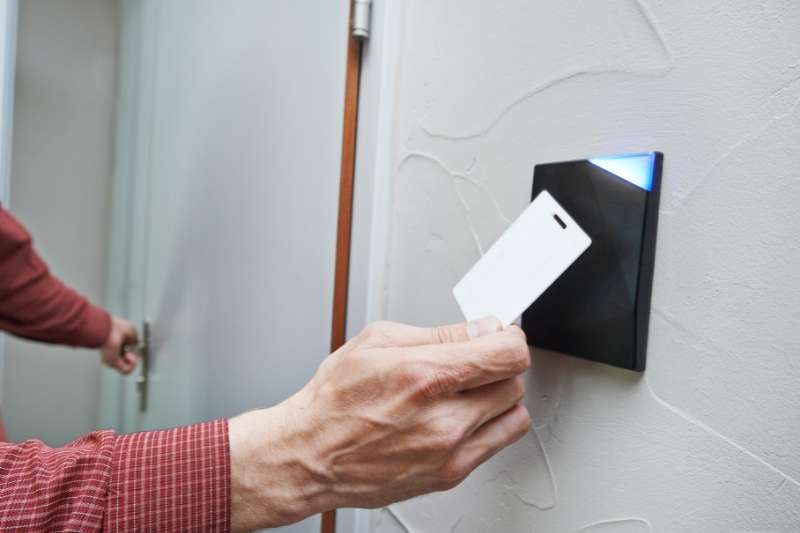
Proximity card reader installation
The installation process plays a major role in the cost of your access control system. Your building’s infrastructure will also impact how your system is installed.
With that said, a significant concern with upgrading to a new access control system is having to rip up floors or walls and replace any existing hardware or wiring.
For this reason, it’s best you choose a solution with as little wiring as needed. So, the best proximity card readers only need a power supply. In turn, installation is fast and minimally invasive.
Proximity card reader software
Lastly, you should consider an access control system with user-friendly proximity card reader software. Additionally, the system’s software should allow you to easily grant and revoke user access remotely. Further, with the best systems, you’ll have access to a proximity card reader app that allows you to easily edit permissions for individuals no matter where you are.
